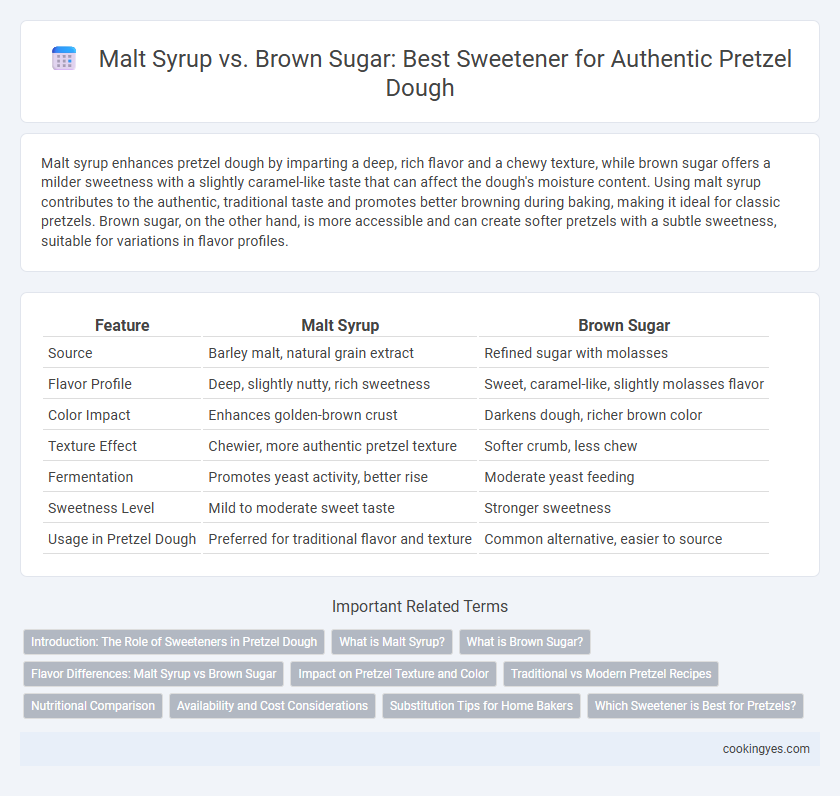Malt syrup enhances pretzel dough by imparting a deep, rich flavor and a chewy texture, while brown sugar offers a milder sweetness with a slightly caramel-like taste that can affect the dough's moisture content. Using malt syrup contributes to the authentic, traditional taste and promotes better browning during baking, making it ideal for classic pretzels. Brown sugar, on the other hand, is more accessible and can create softer pretzels with a subtle sweetness, suitable for variations in flavor profiles.
Table of Comparison
| Feature | Malt Syrup | Brown Sugar |
|---|---|---|
| Source | Barley malt, natural grain extract | Refined sugar with molasses |
| Flavor Profile | Deep, slightly nutty, rich sweetness | Sweet, caramel-like, slightly molasses flavor |
| Color Impact | Enhances golden-brown crust | Darkens dough, richer brown color |
| Texture Effect | Chewier, more authentic pretzel texture | Softer crumb, less chew |
| Fermentation | Promotes yeast activity, better rise | Moderate yeast feeding |
| Sweetness Level | Mild to moderate sweet taste | Stronger sweetness |
| Usage in Pretzel Dough | Preferred for traditional flavor and texture | Common alternative, easier to source |
Introduction: The Role of Sweeteners in Pretzel Dough
Malt syrup and brown sugar serve distinct roles as sweeteners in pretzel dough, influencing both flavor and texture. Malt syrup imparts a deep, malty richness and enhances the pretzel's characteristic dark crust through Maillard reactions during baking. Brown sugar contributes a subtle caramel sweetness and moisture, affecting dough softness and browning intensity, making the choice critical for achieving desired pretzel quality.
What is Malt Syrup?
Malt syrup, derived from malted barley or other grains, is a thick, amber-colored sweetener rich in enzymes that enhance pretzel dough fermentation and flavor development. Unlike brown sugar, which is primarily sucrose with molasses, malt syrup contains maltose and natural yeasts that contribute to the characteristic chewy texture and distinctive taste of traditional pretzels. Its unique enzymatic properties promote browning during baking, resulting in the classic pretzel crust and deep flavor complexity.
What is Brown Sugar?
Brown sugar is a sucrose sugar product with a distinctive caramel flavor due to the presence of molasses, commonly used in pretzel dough to enhance moisture and tenderness. It contains varying amounts of molasses, which contributes to the dough's color and slightly acidic pH, aiding in yeast fermentation. Unlike malt syrup, brown sugar offers a simpler sweetness and contributes to softer texture in pretzels without the malt's characteristic malty aroma.
Flavor Differences: Malt Syrup vs Brown Sugar
Malt syrup imparts a rich, slightly nutty and malty flavor to pretzel dough, enhancing the traditional taste with deep caramel notes. Brown sugar offers a sweeter, more molasses-forward flavor that adds warmth and a subtle hint of bitterness to the pretzel crust. Choosing malt syrup results in a distinctively authentic pretzel flavor profile, while brown sugar yields a softer, sweeter taste with less complexity.
Impact on Pretzel Texture and Color
Malt syrup enhances pretzel dough texture by promoting a chewier crust and a distinctive deep brown color due to Maillard reaction intensification. Brown sugar contributes to a softer crumb and lighter golden hue but can lead to a less pronounced chewiness. The choice between malt syrup and brown sugar directly affects the final product's authenticity, texture, and visual appeal.
Traditional vs Modern Pretzel Recipes
Malt syrup, a traditional sweetener in classic pretzel recipes, imparts a rich, malty flavor and enhances the dough's color and texture by promoting Maillard reactions during baking. Brown sugar, favored in modern pretzel variations, offers a sweeter, caramel-like taste while providing moisture that results in a softer crumb. Comparing these sweeteners reveals malt syrup's role in preserving the authentic chewy bite of traditional pretzels, whereas brown sugar suits contemporary preferences for a tender, slightly sweeter product.
Nutritional Comparison
Malt syrup contains fewer calories and a lower glycemic index compared to brown sugar, making it a healthier option for pretzel dough sweetening. Brown sugar provides slightly more minerals like calcium and potassium but has a higher sucrose content that can spike blood sugar levels. Choosing malt syrup enhances the pretzel's flavor complexity with a subtle, malty sweetness while supporting a more balanced nutritional profile.
Availability and Cost Considerations
Malt syrup is a traditional sweetener for pretzel dough, providing authentic flavor but often at a higher cost and limited availability in regular supermarkets. Brown sugar is more widely accessible and affordable, making it a practical choice for home bakers and commercial producers looking to reduce expenses. Choosing between malt syrup and brown sugar depends largely on balancing the importance of traditional taste versus cost-efficiency and ingredient accessibility.
Substitution Tips for Home Bakers
Malt syrup provides a traditional flavor and chewy texture in pretzel dough, but brown sugar can be an effective substitute for home bakers seeking sweetness and moisture, with a slightly different caramel note. When replacing malt syrup, use brown sugar at a 1:1 ratio but reduce other liquids slightly to maintain dough consistency. For optimal results, dissolve brown sugar in warm water before adding to the dough to ensure even incorporation and replicating malt syrup's binding properties.
Which Sweetener is Best for Pretzels?
Malt syrup is the preferred sweetener for pretzel dough due to its rich, malty flavor and traditional use in authentic soft pretzel recipes, enhancing both color and taste. Brown sugar can also be used but tends to make the dough sweeter and less complex in flavor compared to malt syrup. Choosing malt syrup results in a chewy texture and the characteristic pretzel crust, making it the best option for classic pretzels.
Malt Syrup vs Brown Sugar for Pretzel dough sweetener Infographic

 cookingyes.com
cookingyes.com